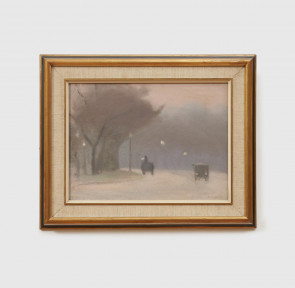Lot #42 - Clarice Beckett
-
Auction House:Bonhams Australia
-
Sale Name:Important Australian Art
-
Sale Date:29 Nov 2022 ~ 6pm (AEST)
-
Lot #:42
-
Lot Description:Clarice Beckett
(1887-1935)
Evening, Alexandra Avenue, c.1930
oil on board
29.0 x 39.5cm (11 7/16 x 15 9/16in).
signed lower right: 'C. Beckett'; inscribed, titled and initialled verso: 85 / Alexander Av / B / Indefinite'
RELATED WORK: Evening, St Kilda Road, c.1930, oil on board, 33.8 x 39.5cm, in the collection of the Art Gallery of New South Wales, Sydney -
Provenance:Rosalind Hollinrake Galleries, Melbourne; Private collection, Canberra
-
Exhibited:possibly, Homage to Clarice Beckett (1887-1935): Idylls of Melbourne and Beaumaris, Rosalind Humphries Galleries, Melbourne, 30 October – 20 November 1971, cat. 27, as Alexandra Avenue
-
Notes:At the age of 32, Clarice Beckett moved with her family to the bayside suburb of Beaumaris in 1919 and remained there for the rest of her life. After studying under the tuition of Frederick McCubbin at the National Gallery School from 1914 she joined the controversial art theorist Max Meldrum who had established his own rival school at 527 Collins Street, Melbourne. Meldrum's beliefs placed the utmost importance on tonal relationships, arguing that 'The art of painting is a pure science – the science of optical analysis'. Beckett closely identified with his methods and practice, adopting a lighter, freer and more impressionist style of painting en plein air, translating to an atmospheric form of painterly abstraction. Beckett 'painted early in the morning and again in the evening, at the edge of day when shadows were long and the light diffuse. There were practical and domestic reasons for both of these choices, rehearsed in every telling of Clarice Beckett, the artist who lived with her parents in the Melbourne beach suburb of Beaumaris. As the unmarried daughter, domestic care for her aging parents fell to her, limiting the work of her art to the time and the place of her circumstances... The freedoms of travel and study in Europe that opened for other woman painting in the years between the wars were not for Clarice Beckett. She never travelled beyond Victoria; she did not even have her own studio. Her father had ruled that 'the kitchen table would do'. But for an artist as serious as Clarice Beckett it did not do, which is why, early each morning and again in the evening, before and after the duties of the day, she set out for the streets and beaches... pulling behind her a small cart for her paints, with a lid that served as an easel for her smaller paintings.. She explored the ambiguity of exactness and illusion, observing small changes in light and shadow, and experimenting with shifts in focus and angle.. she developed the style and sensibility for which she is now known as one of Australia's finest early modernists'1. Beckett made the most of her opportunities, in particular her twilight subjects along the banks of the Yarra River and Melbourne street scenes, many of which are the subject of her most prized works such as Evening, St Kilda Road, c.1930 (in the collection of the Art Gallery of New South Wales, Sydney) and Across the Yarra, c.1931 (in the collection of the National Gallery of Victoria, Melbourne). The present work, Alexandra Avenue, c.1930, positioned between the Yarra River and the Botanical Gardens, is an exquisite example of a subject she knew most intimately. Beckett captures the perfect moment shrouded in a mysterious veil of light. Painted with her distinctive muted palette she presents us with a seamless transition between tones. White daubs of paint emulating street lights float across the picture plane, their precise placement enables a perception of depth to resonate through. Alex Clark 1. Drusilla Modjeska, 'Clarice Beckett: At the Edge', Clarice Beckett, Niagara Galleries, Melbourne, 2014, p. 2
-
Estimate:A$85,000 - 125,000
-
Realised Price:
-
Category:Art
This Sale has been held and this item is no longer available. Details are provided for information purposes only.










